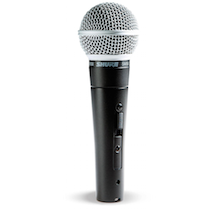You know your students can be LOUD. They talk and laugh with freedom, they play their instruments with gusto, they sing with abandon. But, sometimes, you need them to be even LOUDER. Whether you have an outdoor performance, one in a large auditorium or you need to amplify quieter voices or instruments in any situation, there will probably come a time when you need to set up a PA system. Where do you start?
What is a PA system?
Well, first off, what does PA even mean? The acronym stands for Public Address system and it involves using microphones, amplifiers, loudspeakers and related equipment to increase  the apparent volume of voices, instruments or other sound sources. You may also hear this type of system called a sound reinforcement system.
the apparent volume of voices, instruments or other sound sources. You may also hear this type of system called a sound reinforcement system.
We’ve all encountered PA systems in venues that feature an announcer or performers that need to be heard at a distance or over a large area. A PA system may include multiple microphones or other sound sources, a mixing console to combine and modify sources, and amplifiers and loudspeakers for louder volume or wider distribution.
Main components of a PA system
No matter how simple or complicated the PA system, it almost surely uses these five components.
- Microphones (or line inputs): to convert acoustic sound into electronic signals
- Mixing boards: to process and mix these electronic signals
- Power amp: to amplify signals
- Speakers: to deliver the sound to the audience
- In-ear monitors or speakers: to monitor the performance
What kind of PA system do I need?
Now, chances are, you’re not looking to set up an extremely complicated PA system like those used by arena rock bands. Those require highly trained professionals to set up and cost many thousands of dollars to purchase.
However, for a school band, choir or theatre director looking to amp your students’ voices and instruments, there are great portable and even wireless Bluetooth PA options that are easy to set up, sound great, and won’t bust your budget.
The Behringer PMP1680S / B212XL Mains and Monitors PA Package comes complete with powered mixer, four passive speakers, four dynamic microphones, stands and all necessary cabling, so you can get started amplifying your performance right away.
If you’re looking for mobile and  portable options, you have a lot of choices!
portable options, you have a lot of choices!
Check out this Yamaha Portable PA System with Bluetooth. Its 10-channel powered mixer delivers 680 watts of peak output through its pair of full-range speakers 10" woofers and 1.4" tweeters for clean, room-filling sound.
There’s also the Gemini ES-210MXBLU Portable PA System which is designed to give you great sound without all the bulk. The ultra-lightweight speaker system comes with ergonomic top and side handles so you can easily carry it wherever you need to. Plus, you also get a microphone, 15V of phantom power and all the cables you need.
The Harbinger M60 60-Watt, 4-Channel Compact Portable PA with 10 inch Speakers is a simple solution for anyone needing a portable and affordable sound system for smaller performances, presentations and rehearsals. This system is designed for more intimate spaces, not huge auditoriums or outdoor performances. It includes a 4-channel powered mixer, loudspeakers and speaker cables.
Another great Harbinger package is the L1202FX Mixer and Kustom HiPAC Speakers 12" Mains which offers clean sound and unparalleled control, so you can focus on helping your students perform music.
 PA system accessories and more
PA system accessories and more
If you choose a package that doesn’t include all of the microphones and cables you need, be sure to check out our selection of pro audio equipment and accessories to build out the perfect PA system for your program. Our school music experts are standing by in case you need guidance on what to buy to amp up your student musicians. And don’t forget, we offer the best school music pricing around to help your budget dollars go further. We’re standing by at 800.346.4448 or you can shop on the Educator Website.
Additional resources
If you’re interested in learning more about sound reinforcement and mic’ing up your students, check out these additional articles: sound reinforcement for music & theatre, an introduction to mixers, and how to buy a microphone.
 PA system accessories and more
PA system accessories and more
